A window box is an excellent addition to the beauty of any space.
And if we can grow beautiful and vibrant color flowers in them, then what else would one need?
But do all kinds of flowers do well in window boxes? Definitely not!
So, in this article, I will share the 14 best flowers for window boxes along with their primary care. Let’s get right into it.
Coleus
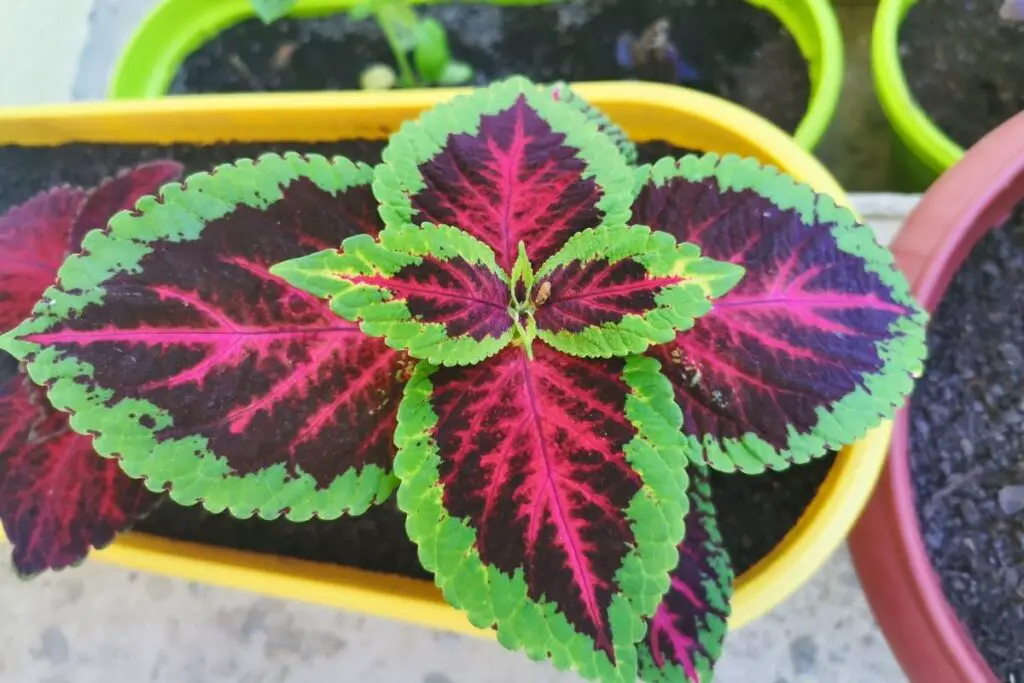
Coleus has colorful foliage with a wide variety of colors shapes and produces tiny flowers in different shades. They appear bushy and fill the space quickly, which can grow in a window box.
Sunlight: Coleus likes light, but light exposure depends on its variety. They do best in partial to full shade. If the sun is too hot, keep them in some shade, especially during the afternoon. In moderate weather, you can keep them in full sun.
Watering: Water the coleus plant to keep the soil most between watering but do not overwater it. Also, make sure the excess water is draining correctly after watering. Keeping the plant dry for longer periods will affect its growth.
Fertilizer: Feed coleus with a balanced fertilizer diluted to half the recommended strength. It is advised to feed only if the soil mix is poor. Feed-in the growing season to encourage growth.
General care: Plant coleus in nutrient-rich, loose soil mix which is slightly acidic. Please keep them in a warm and humid environment. Protect them from frost, as bare exposure to frost may severely damage your plant.
Petunias
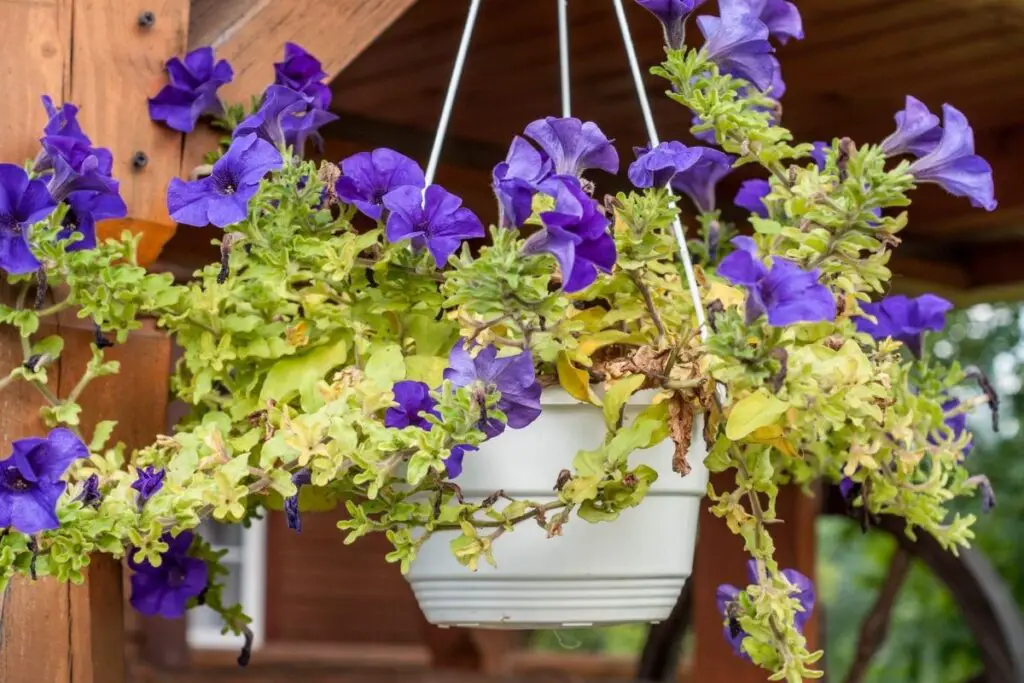
Petunias are a fast-growing flowering plant that blooms in almost all colors. They look stunning at the edge of your window as they grow bushy and spillover beautifully.
Sunlight: for healthy and blooming petunias, expose them to full sun for at least 6 hours a day. Please keep them in partial shade during the hot sun to protect flowers from any sun damage.
Watering: Petunias like to stay moist but always prefer under watering instead of overwatering. Never keep them in soggy soil and water only when the halfway soil is dry.
Fertilizer: It is advised to feed with balanced fertilizer petunias at the time of planting. You can add some compost also to add to the nutrient value. Feed them from spring till fall with liquid fertilizer formulated for the flowering plant.
General care: Petunias thrive in temperatures between 60°F to 75°F and can bear temperatures below 40°F. Frost can kill the plant, ensuring to keep them in a safe spot during freezing temperatures.
Creeping jenny

Creeping jenny is known for its leaves which creep over the walls or around the window when kept in a window box. They produce tiny flowers in many shades but don’t last long.
Sunlight: Creeping jenny thrives in full sun and will grow well in indirect light too. In hot summer, please keep them in partial shade. Low light will inhibit its growth.
Watering: Creeping jenny likes moist soil but does not keep the soil soggy. Do not let the soil dry out, and water it regularly to keep the soil moist.
Fertilizer: Fertilize creeping jenny with balanced fertilizer by diluting it to half the recommended strength. Fertilize from spring through summer and avoid winter.
General care: Creeping jenny likes warm temperatures and can survive in cold winters too. Please keep them in humid conditions.
Looking for gardening supplies? We have tested 100's of products before recommending them to you guys. Check out our best pick below:
| Image | Gardening Supplies | Best Price? |
|---|---|---|
 Top
Top Top
Top | Raised Garden Bed Kit | Check On Amazon |
 | XLUX Soil Moisture Meter, Plant Water Monitor, Soil Hygrometer Sensor for Gardening, Farming, Indoor and Outdoor Plants, No Batteries Required | No Results |
 Top
Top Top
Top | 82 Pcs Garden Tools Set and Extra Succulent Tools Set | Check On Amazon |
 | Joeys Garden Expandable Garden Hose with 8 Function Hose Nozzle, Lightweight Anti-Kink Flexible Garden Hoses, Extra Strength Fabric with Double Latex Core, (50 FT, Black) | No Results |
 Top
Top Top
Top | Dual Chamber Compost Tumbler | Check On Amazon |
 Top
Top Top
Top | Sunnyglade Plant Stakes | Check On Amazon |
 Top
Top Top
Top | Organic Cold Pressed Neem Seed Oil | Check On Amazon |
 Top
Top Top
Top | Mighty Mint Gallon :-Insect and Pest Control Peppermint Oil | Check On Amazon |
 Top
Top Top
Top | Scotts DiseaseEx Lawn Fungicide | Check On Amazon |
 Top
Top Top
Top | Jacks Classic 20-20-20 All Purpose Fertilizer | Check On Amazon |
 Top
Top Top
Top | 30,000 Seeds Pollinator Attracting Wildflower Mixture | Check On Amazon |
 Top
Top Top
Top | Survival Vegetable Seeds Garden Kit-Over 16,000 Seeds | Check On Amazon |
Dusty miller
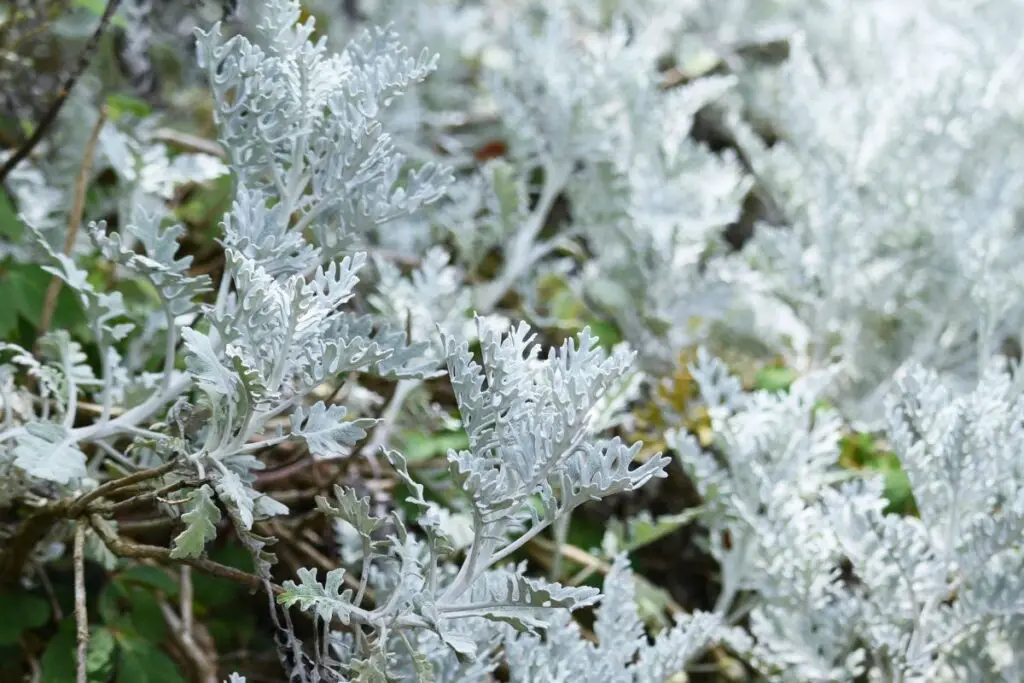
Dusty miller has silver leaves that contrast with its colorful flowers. They are easy to maintain, drought tolerant and look stunning in a window box.
Sunlight: Dusty miller needs a lot of light to maintain its foliage, and in low light, it can become leggy. Please keep them in bright light for as many hours as you can.
Watering: Dusty miller can be watered to keep the soil moist but not soggy. Soggy conditions will lead to root rot and can kill your plant.
Fertilizer: Fertilize dusty millers only if they are growing in the poor soil mix. Fertilize with a balanced fertilizer in the growing season. You can also add manure to improve the nutrient content in the soil.
General care: Dusty miller likes hot weather and warm temperatures. Please keep them in humid conditions, ensuring they are kept in a well-ventilated space.
Fuchsia
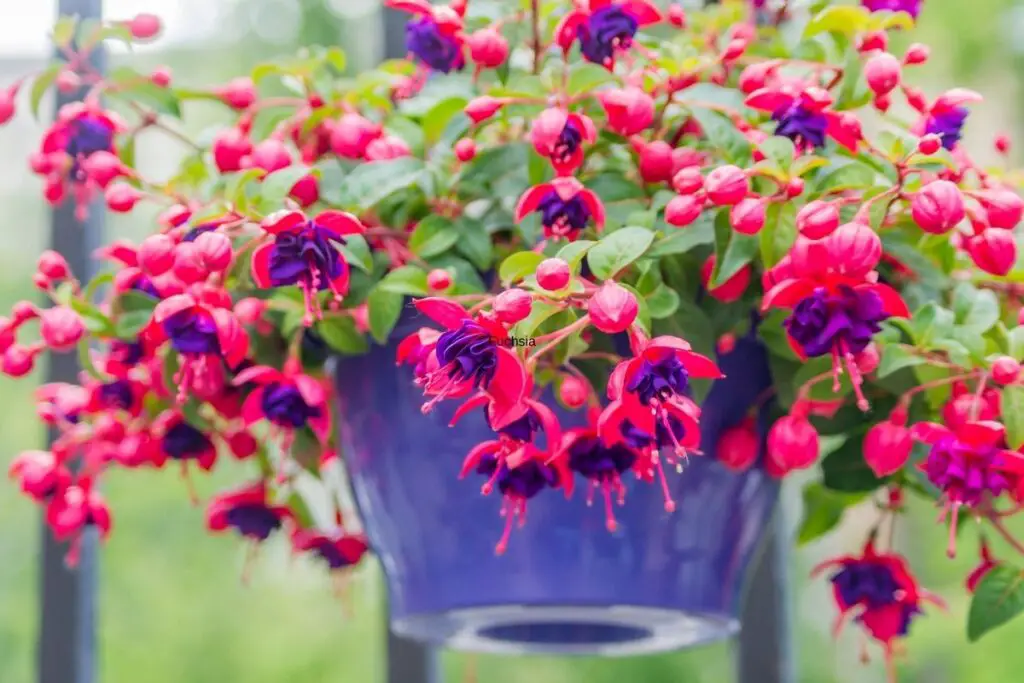
Fuchsia has teardrop-shaped blooms and does well with its trailing stem in a window box. They have a moderate growth rate and are sensitive to cold.
Sunlight: Fuchsia likes partial-full shade in their native environment, but indoors they can be kept in indirect bright light. It helps them to produce flowers.
Watering: Water fuchsia in regular intervals to keep its soil moist. Do not overwater as it can lead to root rot. Water when the soil feels dry to touch, do not let the soil dry out completely.
Fertilizer: Fuchsia needs feeding, especially during the blooming season. Feeding them with a diluted all-purpose fertilizer or combination of fish emulsion also works well.
General care: Fuchsia thrives in humid conditions. If the environment is dry, they must regularly maintain high humidity. They can bear temperature levels from 55°F to 80°F. Ensure the pot has a proper drainage system.
Impatiens
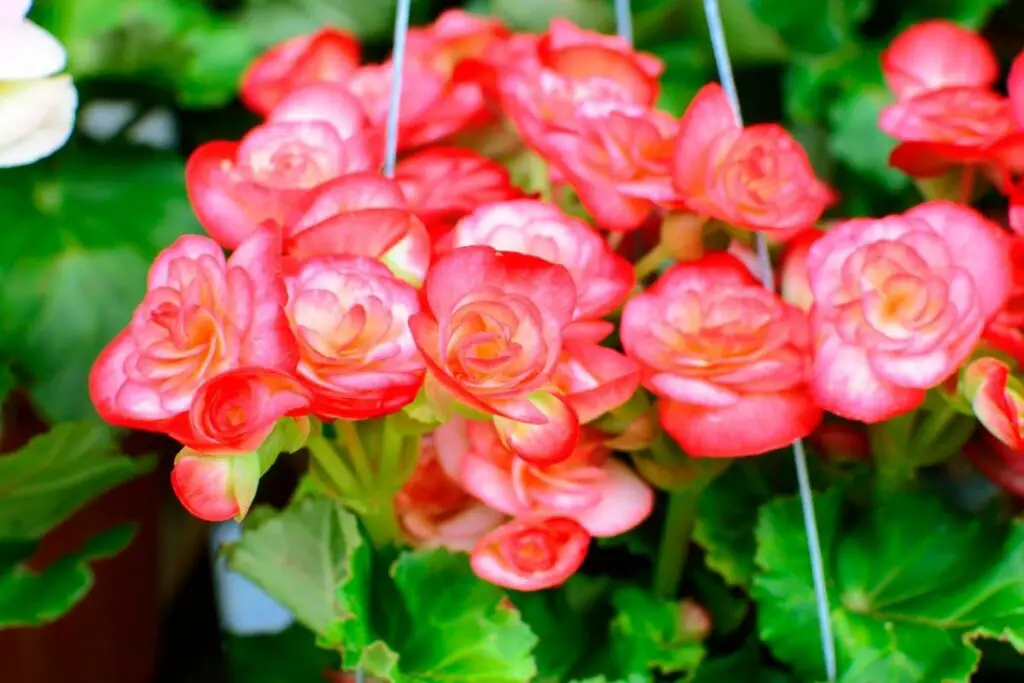
Impatiens are popular for their beautiful bright flowers that can grow even in shade areas. It is a great option to grow in your window box, even in the directions with low light available. They are short plants, and their colorful flowers will brighten your window.
Sunlight: Impatiens appreciate a lot of light, and with other conditions in check, they can grow in sunny locations too. They thrive in a shady location and will bloom even in low light.
Watering: Impatiens should be watered regularly if the temperature level is consistently high to keep the soil moist. Water them daily when grown in window boxes in temperature levels above 85°F.
Fertilizer: Fertilize impatiens with diluted regular fertilizer once a month from spring through summer. Avoid feeding during the dormant season.
General care: Impatiens should be grown in a well-draining soil mix and pots with the proper drainage system. They are sensitive to heat, and it is advised to keep them in high humidity to avoid related issues. Trim them in the late summer to promote new blooms.
Snapdragon
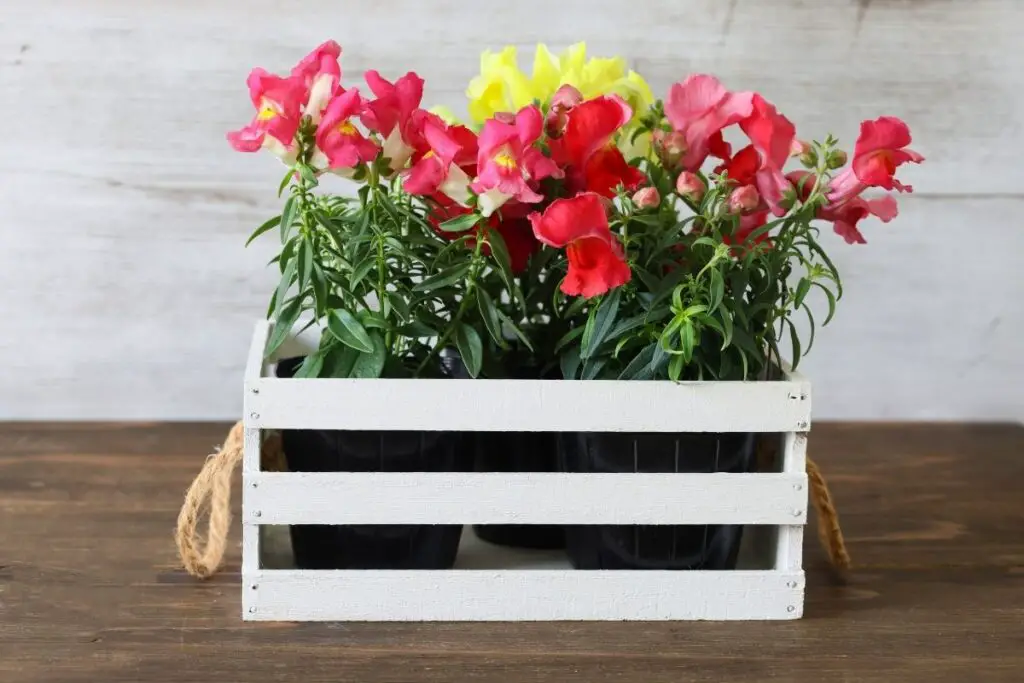
Snapdragon has trumpet-shaped flowers with fleshy leaves that will catch everyone’s eye when grown in any window box. They bloom in different shades such as pink, lavender, white and blue.
Sunlight: Snapdragon appreciates full sun and will thrive in part shade too. Keep them in partial shade during the afternoon if the sun is too intense.
Watering: Water snapdragon in regular intervals to keep the soil moist. You can also water it 1 inch/week regularly, which will keep the soil moist and help them survive drought conditions too.
Fertilizer: Fertilize snapdragon in the growing season with diluted fertilizer. You can also add compost as a side dressing to help them keep blooming.
General care: Snapdragon is hardy and can grow in both arid and humid conditions. They can even grow in poor soil but growing them in well-draining, and organically rich soil is best.
Verbena
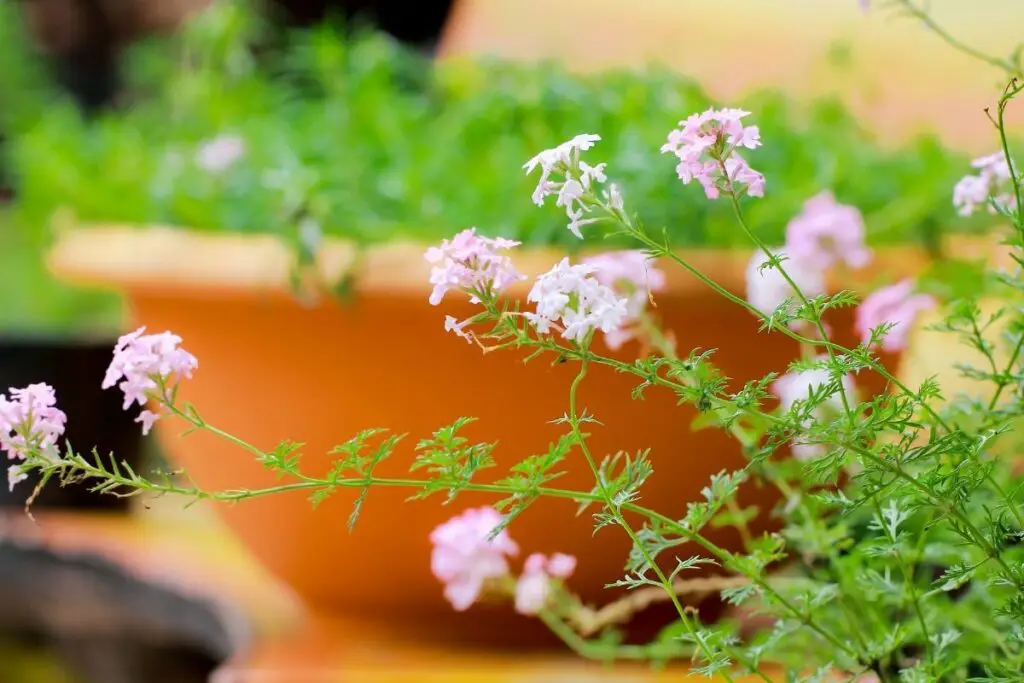
Verbena gives a cascading effect to your window boxes and other containers. They produce flowers in different shades like red and white, bright purple and white, etc. they are fast-growing and mature in a few months.
Sunlight: Verbena likes full sun and can bloom in such conditions easily. Flowering will inhibit if the light conditions are low. Expose them to light for 8-10 hours a day.
Watering: Water verbena to keep them moist when young. When matured, let the soil dry between watering. They have low water needs and are drought-tolerant, and it’s best to keep the soil moist and never soggy.
Fertilizer: Fertilize verbena monthly in the growing season with balanced flower fertilizer. Fertilize by diluting to half the strength; it will keep them blooming until frost.
General care: Verbena needs dry and acidic soil to stay healthy. Please keep them in moderate conditions as hot summers can affect their health.
Variegated ivy
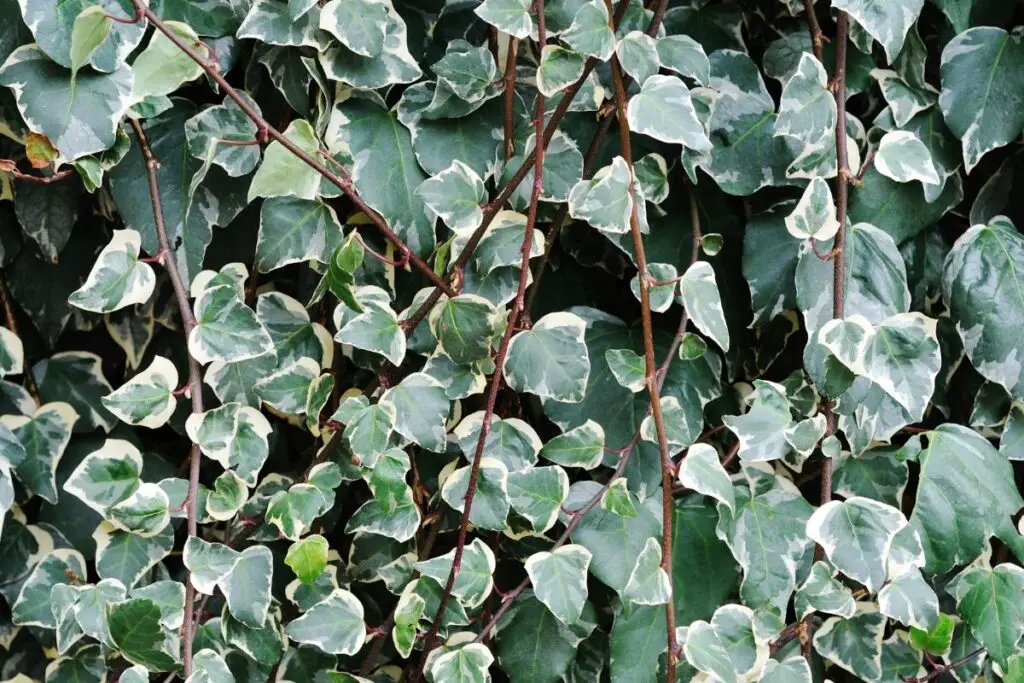
Variegated ivy is a tough trailing plant available in different varieties. They will brighten any space you keep them in and will fill your window box, soiling over its edges.
Sunlight: Variegated ivy will grow best in good lighting. Light is required to maintain their variegation. Also, low light will make it leggy, weak, and prone to pests.
Watering: water variegated ivy to keep them slightly moist but not soggy. Touch the soil; if it feels dry, water the plant. Soggy soil will lead to root rot.
Fertilizer: Feed variegated ivy in the growing season with an all-purpose fertilizer. Dilute the fertilizer to half the recommended strength.
General care: Plant variegated ivy in well-draining soil mix and ensure proper drainage system in the pot. Mist around it to keep the humidity level high and prefer moderate temperature levels. If the vines grow too long, you can trim them and propagate them as well.
Licorice plant
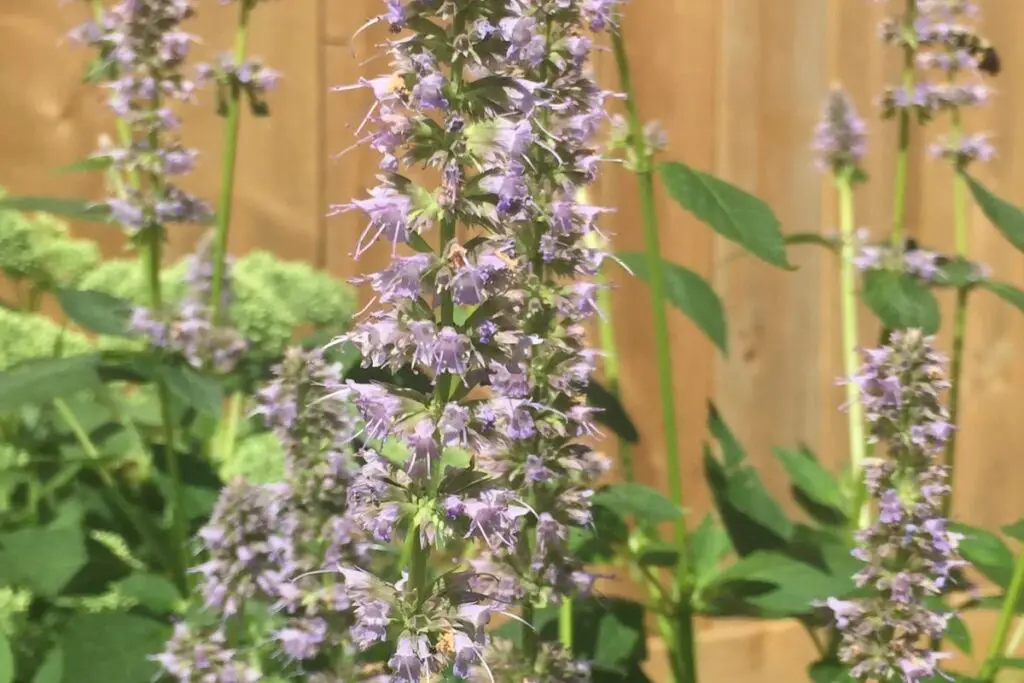
Licorice plant has felt-like velvety foliage with unique texture color and makes an excellent plant for your window box. They have small insignificant flowers and may not flower at all also.
Sunlight: Licorice plant appreciates and grows well in full sun. They will do okay in partial shade too. Please keep them in partial shade in hot summers, especially during the afternoon.
Watering: Water licorice plant regularly, keeping the soil moist but not wet. They are drought tolerant but watering regularly will benefit them. Water when the top few inches of the soil is dry.
Fertilizer: Licorice plants are light feeders and will benefit from slow-release fertilizer once in spring and once in mid-season. If your soil is poor, then you can add compost to add some nutrients to the soil.
General care: Keep your licorice plant in warm temperatures; they cannot bear frost. Please keep them in a safe spot in freezing temperatures. Trim its stems when it turns brown to save the plant’s energy and look healthy.
Erigeron
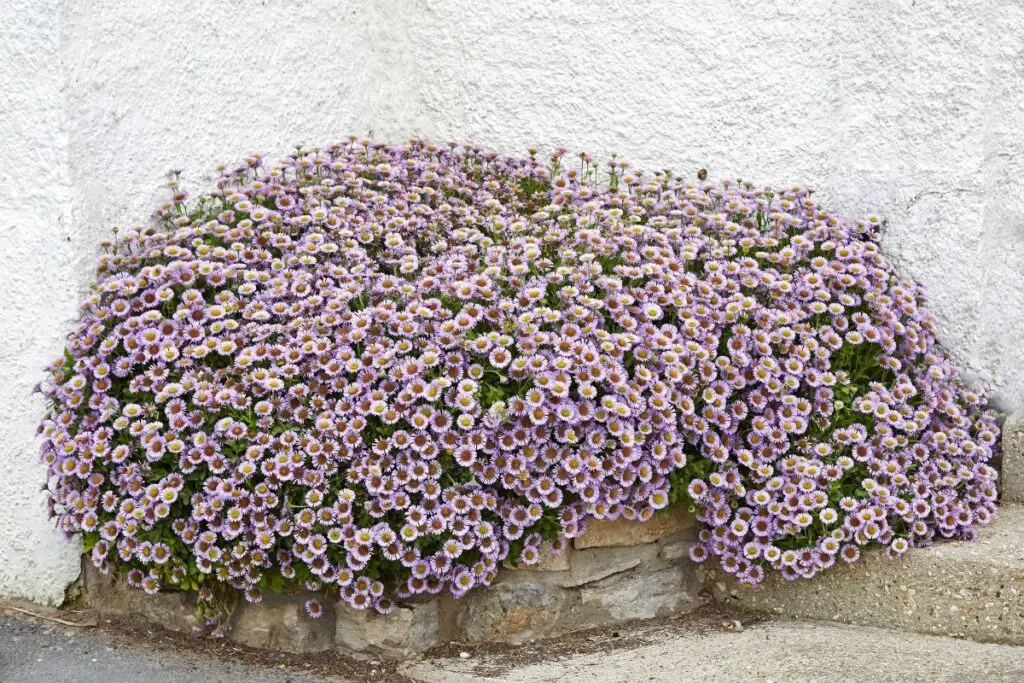
Erigeron is low maintenance, touch flowering plant that will brighten your window box with its bloom from spring through autumn.
Sunlight: Keep Erigeron in full sun to promote flowering. They will do okay in partial shade too, but full sun is best for their growth and development.
Watering: Water Erigeron in regular intervals to keep them moist and happy. They are drought-tolerant but will grow best if watered regularly. Do not keep the soil drowning though.
Fertilizer: Fertilize Erigeron before planting and during the growing season. Feed with balanced fertilizer by diluting it to half the strength.
General care: Erigeron blooms from spring through autumn, deadhead after the first flush to encourage blooming again. Cut the stems from the base at the end of the autumn.
Spring bulbs
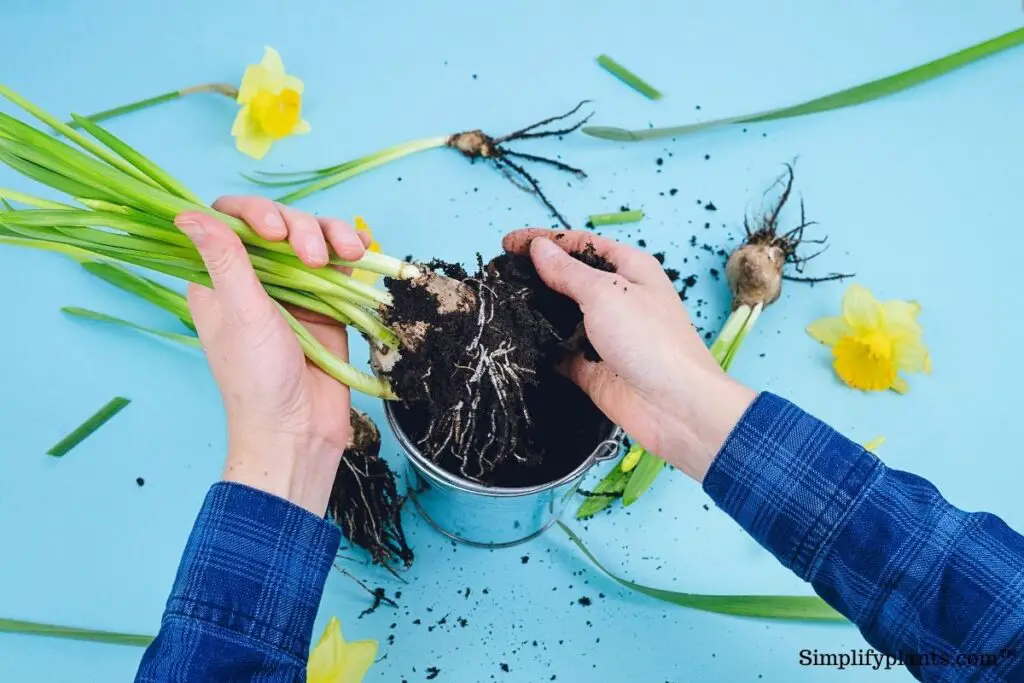
Spring bulbs like daffodils and grape hyacinths can be grown in a window box. They bloom in spring, and by mid-summer, they rest. They have unattractive foliage but beautiful blooms which add height and color to any space.
Sunlight: Keep summer bulbs in good lighting. Expose them to direct light or partial shade but not low light. Low light can affect their flowering and make them weak.
Watering: Water spring bulb to keep the soil moist but not soggy. They can stay dry for some time, but long periods of drought can affect their growth and flowering.
Fertilizer: Spring bulbs generally don’t require fertilizer, but if you can, if you wish to. Fertilize them while planting or in early spring. Use bulb food available in the market as per the instructed ratio.
General care: Spring bulbs like warm to hot temperature levels. Do not mist around them and maintain average humidity. Do not trim them; let the foliage yellow naturally. Also, remove blooms as they begin to fade to save the plant’s energy to produce seed.
Sempervivums
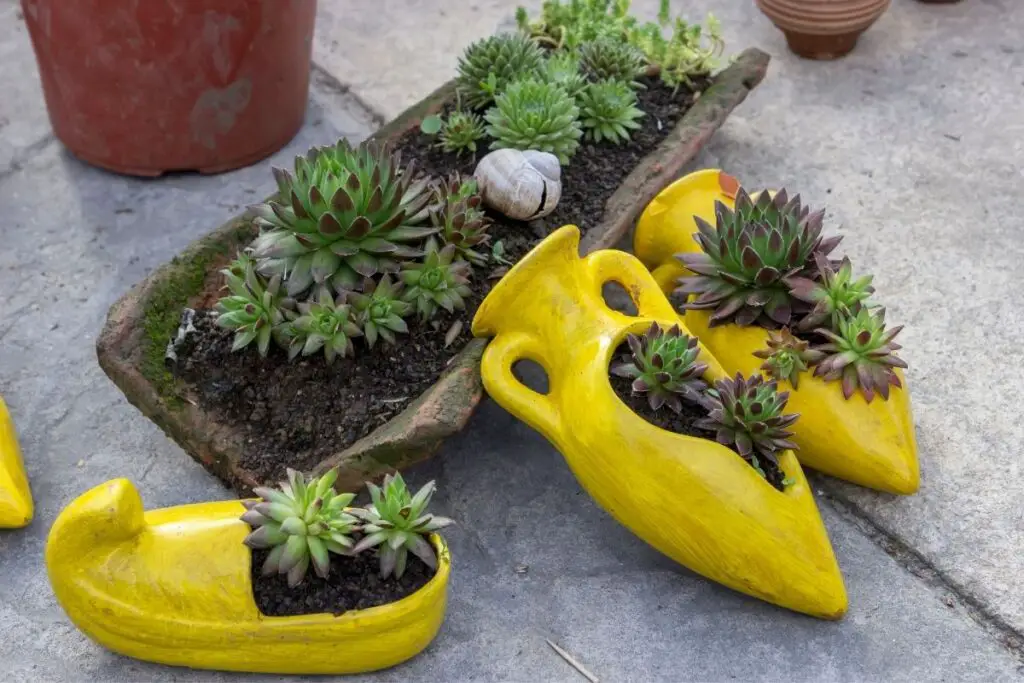
Sempervivums are sturdy succulents that have lovely rosettes that will surely attract attention. They are easy to grow and will increase the beauty of your window. They can do well even on neglect and are simple to multiply.
Sunlight: Sempervivums love full sun but can grow in less light too. It is perfect for windows receiving direct light. If there is a lack of light, do not worry; it will still grow well.
Watering: Water sempervivums to ensure the soil is evenly moist or dry but never soggy. Overwatering or too much watering can affect its health. Reduce watering in cooler months and check the soil before watering.
Fertilizer: Fertilize young plants with fertilizer with less nitrogen, and for mature sempervivums, apply balanced fertilizer. Dilute the fertilizer to halt the strength and feed only during the growing season.
General care: Sempervivums prefer temperature levels ranging between 65°F to 70°F. Most of their species are frost hardy but ensure which species you are growing.
Daffodils
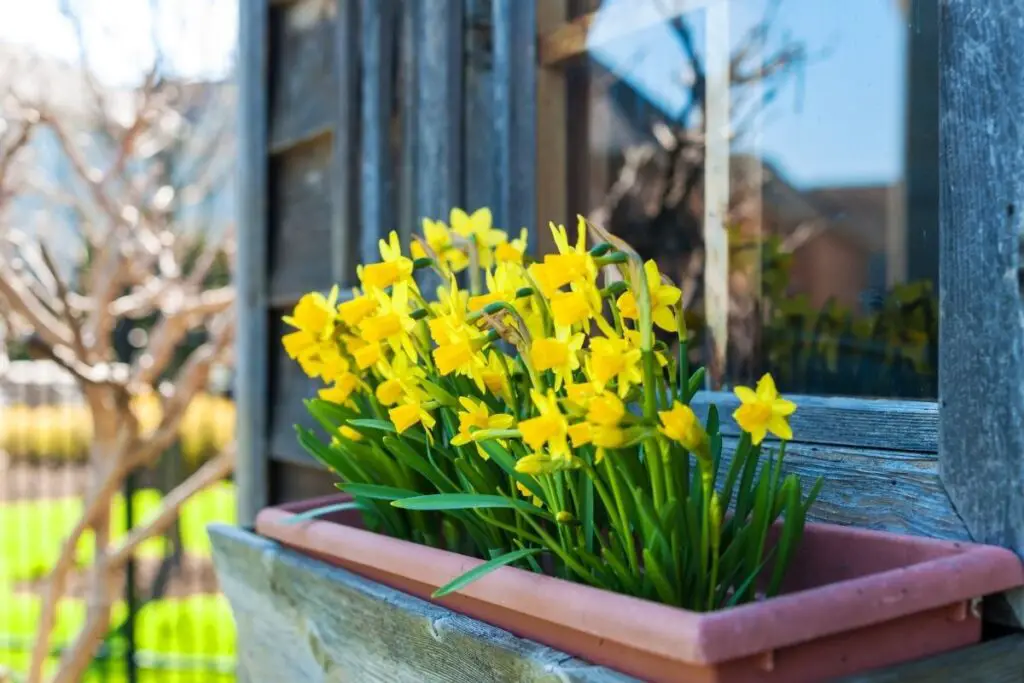
Sunny daffodils look magnificent as they produce stunning sunny yellow blooms in the early spring. They are easy to grow and will brighten your window box.
Sunlight: Daffodils perform best in full sun, but they will grow well in partial shade or low light too. Good lighting is advised to keep your daffodils in the best condition and help flowers grow forward.
Watering: Water daffodils during hot months regularly to keep the soil moist. Avoid overwatering it and stop watering one month after the flowers fade. Ensure proper drainage for everlasting plants.
Fertilizer: Fertilize daffodils if the soil is poor or if they are not flowering up to the mark. Top dress with bulb fertilizer or bone meal when leaves start to emerge. You can feed them again when they flower.
General care: Daffodils are hardy and need cold months to set roots. Some of its species grow in warmer climates with adequate watering. They do not need humid conditions and prefer neutral to slightly acidic soil.
Reference: Louisiana State University Agricultural Center, University of Kentucky, MSU, University of New Hampshire Cooperative Extension.
